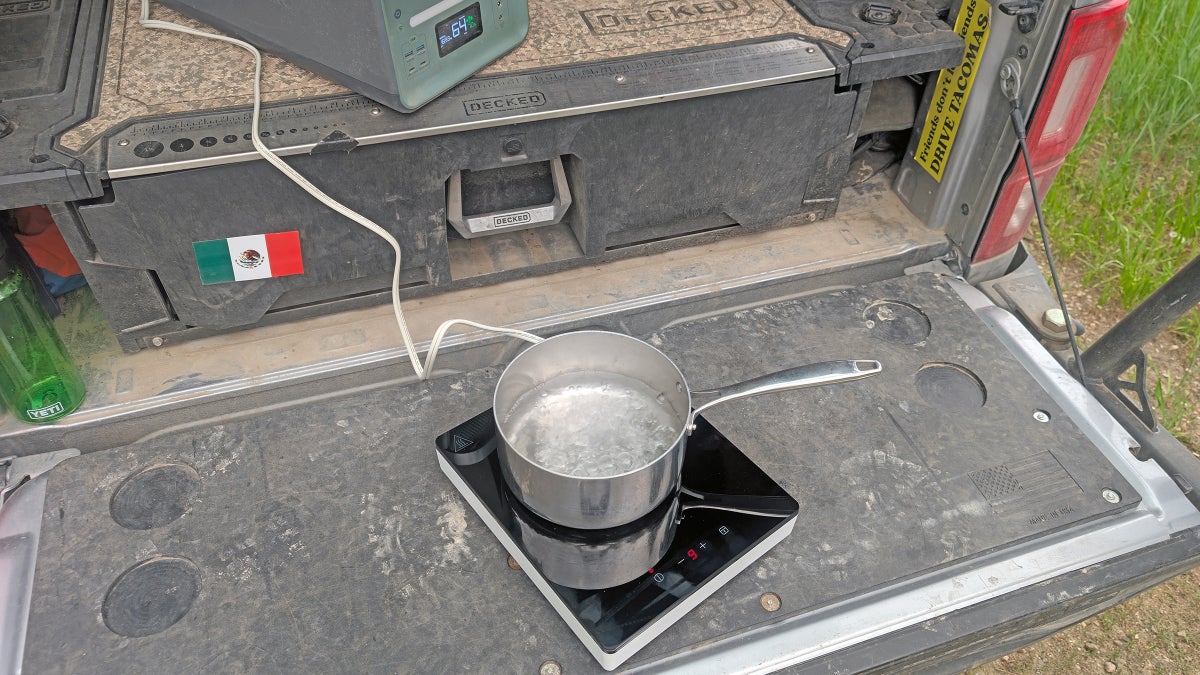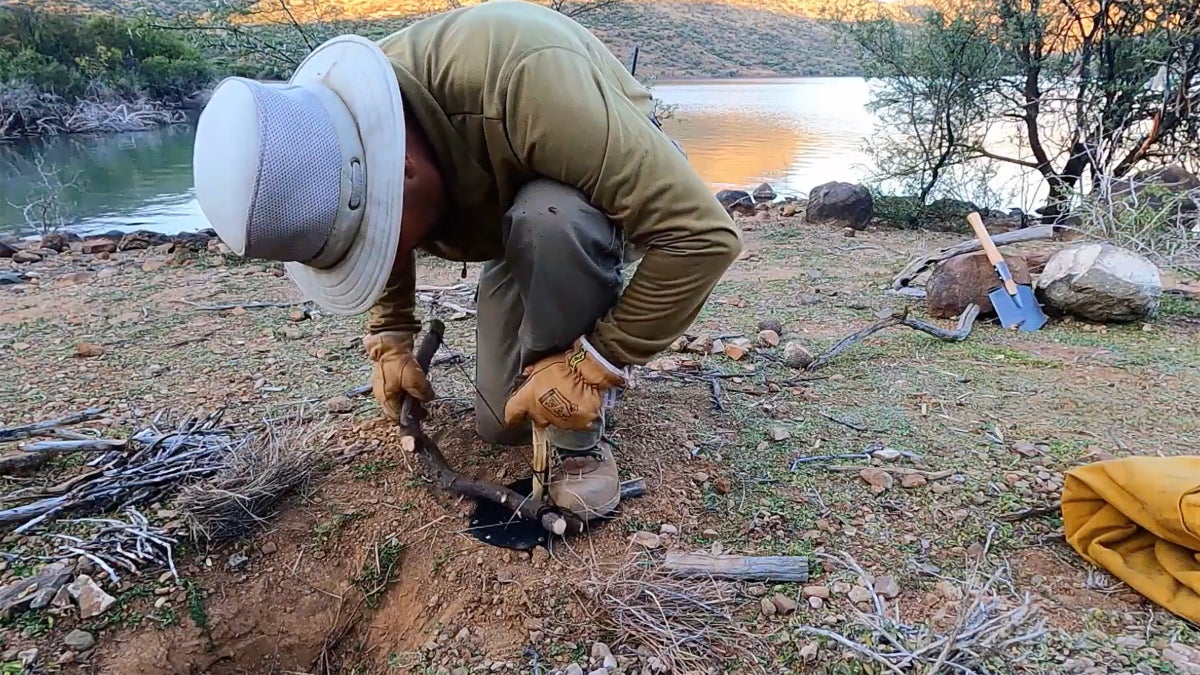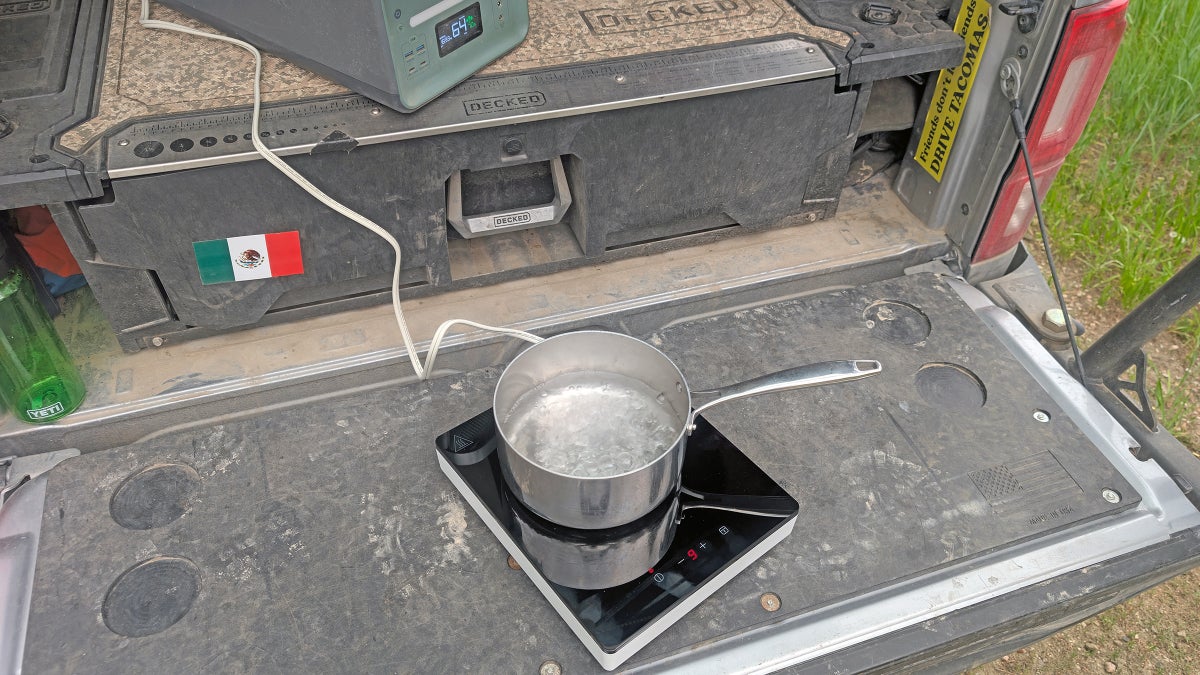
I just made the switch to an all-electric cooking system for car camping. The setup includes an induction cooktop, which uses an electromagnetic field in lieu of direct heat to cook food. While many people associate induction with lower air pollution or faster cook times, I switched for three different reasons: convenience, packed size, and the ability to “refill” my energy stores in camp.
An important piece of background here is that high-capacity power stations—basically big batteries housed in convenient boxes with all the management functions and charge ports built in—have become commonplace for adventurous car camping, a hobby sometimes referred to as “overlanding.”
Carrying a power station enables you to power gadgets like 12-volt fridge-freezers, charge your phone and camera gear, and light up your camp. As the price, size, and weight of these power stations decrease, the amount of energy people are taking outdoors increases. And that has fueled a growing ecosystem of electric accessories which allows you to travel with hitherto unprecedented level of connectivity and convenience.
My two favorite electric items? Heated sleeping pads made by Ignik and Starlink’s satellite internet dish. The former add an incredible amount of comfort in cold weather, while the latter gives me the ability to work from anywhere, even my favorite beaches in extremely remote areas of Mexico. Together, all that helps me enjoy more time outside, even if I’ve got a deadline, and even if the weather’s not great.
But a big battery pack still takes up a lot of space in my relatively small Ford Ranger, especially given that I’m also bringing along my wife Virginia and three big dogs (Wiley, Bowie, and Teddy), and that one of the things we enjoy most about camping is cooking. Figure in a 95-liter fridge with one half packed full of gourmet ingredients and the other full of the frozen chicken drumsticks I base the dogs’ raw diet around—plus tools, tire equipment and recovery gear—and the truck bed fills up fast. That’s becomes a problem when I’m then trying to pack in a 10-pound propane tank and a big freestanding two-burner Camp Chef Mountaineer stove ($470), along with pots, pans, dishes, and other kitchen gear.
Swinging by my storage unit to pack all that up before hitting the road has started to feel like a real burden, and it’s eating into space I could better use for sports equipment and travel supplies, especially on extended trips like the the three months we spent camping our way around Baja last year. That’s what led me to induction cooktops.
I wanted to try out induction cooking before blowing a bunch of money. So, I ordered a $60 Ikea cooktop called the Tillreda, which translates to “prepare.” While not designed for outdoor use, or to withstand the vibration, dust, and general abuse of off-road travel, I figured it was as good a test platform as any. It’s reasonably powerful at 1800 watts (more on that below), and is a relatively svelte six pounds that loosely measures about one square foot.
What Is Induction Cooking?
Where gas burners transfer heat to a pot or pan through a flame, induction cooktops create a magnetic field that excites the particles in the pot or pan, generating heat directly from the metal rather than from the cooktop.
That process is more efficient than using liquid fuel to produce a flame, since all the heat transfers directly into the contents of the pot or pan, rather than being lost to the space around it.
This does, however, require the use of cookware made from ferrous materials—steel and cast iron. You can’t use aluminum, titanium, or ceramic cookware on an induction stove. Typical enamelware, which is made using a cast iron core, works just fine, since the coating doesn’t hamper the magnetic field. Simply put: if a magnet sticks to it, you can use induction to cook with it.
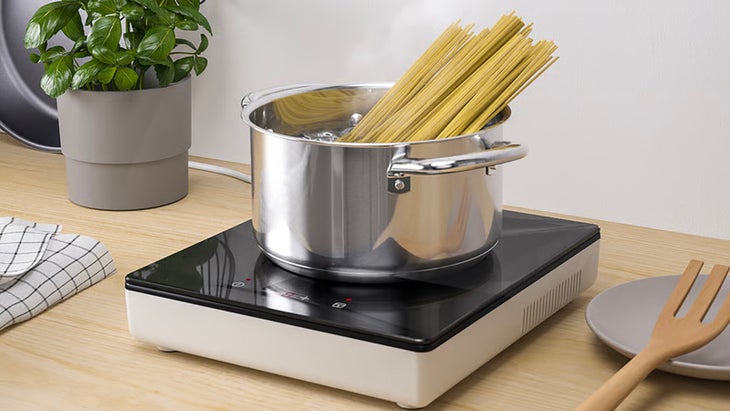
Induction Versus Propane, in Numbers and in the Real World
The reason the Camp Chef Mountaineer has been my car camping stove of choice for so long is that its two burners each produce 20,000 British Thermal Units (BTUs), or around twice the power of the burners used in most propane camp stoves. That brings big pots of water to boil fast, and can put a solid sear on a steak through a cast iron pan without turning the meat’s interior grey.
The formula for comparing the output of a propane stove to that of an induction cooktop is to multiply the latter’s wattage by 3.41. So, that means my new 1,800-watt Ikea is only equivalent to about 6,100 BTUs.
But there’s more to a stove’s power output than its BTUs, especially outdoors. Induction setups are immune to variables like windspeed and elevation since there’s no combustion, and all the heat they produce goes directly into whatever you’re cooking. So, the difference in power output is less than the raw numbers might indicate.
One factor you have to consider with induction that really isn’t a concern with gas is the size of your cookware. The magnetic fields produced by induction only propagate directly over its coils, so you need to use a pot or pan that loosely matches the size of those coils, which you can’t see below the glass top. Referring to the Ikea cooktop’s manual, I learned this thing works best with cookware that measures between 4.7 and 7.9 inches in diameter. That’s not very big. The outright size of a pot or pan I can use on a propane stove is limited only by its windshield; the Mountaineer can handle cookware about 14 inches in diameter.
The time-to-boil for four cups of water was about 4:40 seconds on both devices. I controlled variables by using the same 8-inch pot with no lid (so I could watch for the moment of roiling boil). I also used water directly out of my home tap set to cold, and I performed both tests here at our home in Bozeman, which sits at about 4,800 feet in elevation.
That result surprised me, given the big delta in BTU equivalents between the cheap induction cooktop and the powerful gas stove.
Less surprising was the consistency provided by the induction unit at lower heat levels. Again, without factors like wind or gas flow getting involved, the heat level you select (1-9 on this thing) just sets and holds at a precise temperature, with no fluctuation. And that leads to more consistent, predictable results. Induction is a joy to cook on.
Pros and Cons For Induction vs. Propane
Boiling that water on the induction cooktop drew about 1,700 watts from my power station and depleted 5 percent of its 2,611kWh capacity. That means the cheap Ikea unit isn’t achieving its full power rating. But rather than seeing that as a negative, I’m instead encouraged that level of insight is possible. I have no idea whether or not my propane stove is producing its advertised output, or what amount of fuel it drew from the big 10-pound tank. So add the ability to carefully monitor and manage energy use to this list of pros .
Pros of Induction Cooktops:
- Safety: There’s no flame or carbon monoxide. The surface returns to ambient temperature soon after hot cookware is removed. This will be especially important for people who cook inside a tent, camper, or other structure.
- Speed: Even a cheap unit boils water as quickly as a supposedly much-more-powerful propane burner operating in ideal conditions.
- Impervious to conditions: The burner is unaffected by wind or elevation.
- Size and Weight: Induction cooktops are much slimmer than similarly powerful propane burners.
- No fuel: Induction cooktops draw energy from the power station you’re likely already carrying.
- No waste: Without fuel bottles, there’s nothing to throw away.
- Refill anywhere: Whether you charge your power station while driving, from solar panels, or both, there’s no need to find a refill station or retailer.
- Easy clean up: Even after a big, gross spill, cleaning the glass surface of an induction cooktop should never require more than a wipe with a damp microfiber cloth.
- EV-compatible: If the limited infrastructure available in the U.S. isn’t a problem for you, and you use an EV as your adventuremobile, then all you likely need is the induction cooktop. Just plug that directly into that EV’s outlets.
Cons of Induction Cooktops:
- Fragility: Electric devices are prone to damage from weather, vibration, and dust intrusion—i.e., stuff you’ll likely encounter while camping. While the glass surfaces are pretty robust, they’re still glass.
- Limited repairability: If your cooktop breaks in a more significant way than blowing a fuse, you’ll probably need to replace it.
- Requires specific cookware: I haven’t found this at all challenging, but I do have to leave my fancy MSR titanium pots at home.
- Requires a power station: You’ll want one that can output at least 2,000 watts, and with enough capacity to handle the kind of cooking you plan to do. Calculating those numbers is easy. Finding the cash to pay for them can prove harder.
- Power demands: You’ll need a vehicle to transport that power system.
Pros of Propane Stoves:
- Universal availability: I could have purchased a propane camp stove at virtually any outdoors-adjacent store here in Montana. In contrast, I had to order the induction cooktop online and wait a week for it to arrive.
- Durability: Camp stoves are designed to withstand the hardships inherent in camping.
- Repairability: If you’re handy and carrying a multitool, you can usually fix a broken or damaged propane stove in a few minutes.
- Size and weight: Propane and isobutane stoves are available in a wide range of sizes, weights and outputs. You can grab an ultralight system for backpacking, or a giant setup for feeding a group while car camping.
Cons of Propane Stoves:
- Conditions impact performance: Both wind and elevation can significantly increase cooking times.
- Limited fuel: You have to find a refill station if you have a big tank and an outdoor gear store if you’re using disposable bottles.
- Safety: With open flames and harmful emissions, you can’t use propane inside an enclosed structure, and need to be careful with it even outside.
- Weight and space: You’ll need to carry a fuel bottle, in addition to the rest of your cooking setup.
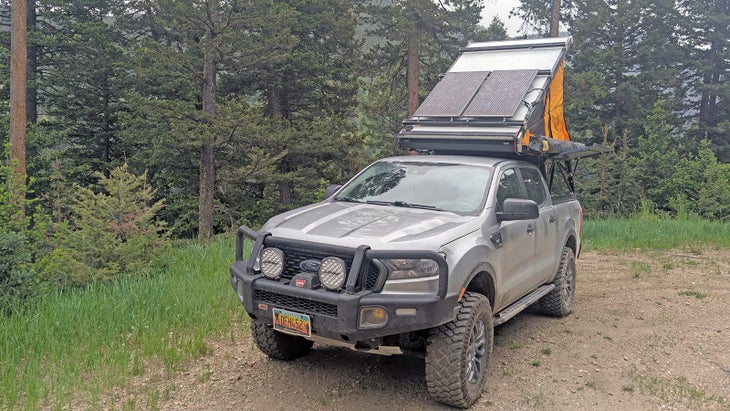
How Do You Power Induction?
I’ve been through a bunch of iterations with my own power setup, and found that, like most things, you get what you pay for. The cheaper battery packs I’ve used from budget brands have all failed prematurely, usually in the middle of a trip, which has caused significant problems in my ability to transport fresh food, or log into the internet to file a story or make a meeting. Crappy off-brand solar panels produce nothing like the output they advertise. And my last set of those just randomly stopped working one week into that three-month trip through Baja.
It’s involved a significant upfront expenditure, but I feel I’ve arrived at a vehicle-based power setup I can rely on. Since this guarantees my ability to work remotely, and means I’m not wasting expensive food, or compromising the quality of the ingredients my wife and I—or our dogs—consume, the value is there for us. The fact that we can now cook with it just takes make the proposition even more compelling.
Solar Panels
I’m using two 110-watt Zamp Obsidian solar panels of a new design that’ll be released in coming weeks, in addition to a 100-watt Zamp Obsidian portable panel ($450). Adding the portable panel speeds charge times for when I’m running multiple high-draw devices, like both the induction cooktop and Starlink, or when I’m parked in the shade. That water boil test consumed about 130 watts of power, which can take as little as a half-hour of sun exposure to make up for with the portable panel deployed. Zamp makes these panels by hand in Bend, Oregon, and provides customers with a 25-year warranty.
Not sure if you need solar power? If you’re only camping for a night or two at at time, the answer is probably not. Just recharge your power station on home power before you leave, and top it up on your vehicle’s alternator while you drive.
Power Station
With first-in-space solid-state battery technology, Japanese brand Yoshino is able to pack more capacity into less size and weight than anyone else in the space. This B4000 ($3,299) holds 2,611kWh of energy, and can handle loads of up to 4,000 watts. The solid-state battery composition also helps the power station remain operational in extreme cold—the minimum ambient temperature in which it’s rated to work is -0.4 degrees Fahrenheit. It will also last longer than other batteries, with a lifespan to 80 percent capacity of 4,000 complete charge/discharge cycles.
How Much Power Do You Really Need?
Determining your total power needs is simple. Simply add up the total draw of the stuff you need to power then compare that against a power station’s maximum output. Then make sure its capacity is balanced with charge times.
An 1,800-watt induction burner, for instance, draws 1,800 watts an hour, or 1.8kWh. Figure 30 minutes of use a day, or 900 watt-hours, and I need to carry at least 900 watts of capacity, along with the ability to replenish it if I’m going to be out for more than two days. If you’re looking to save money, sizing a power station as closely as possible to your exact needs is an effective approach.
The rule of thumb for solar panels is that you should be able to rely on 75 percent of a panel’s rated output for five hours of direct sunlight a day. So, with up to 300 watts of solar on my truck, I’m reliably producing at least 1,125 watt-hours each day, provided that I don’t park underground or indoors. That’s more than enough to replenish any power I use heating up water for coffee, frying up bacon and eggs for breakfast, and cooking an elaborate dinner. Those are all tasks that, armed with this induction cooktop, I can now perform without carrying a giant propane bottle, creating fire or carbon monoxide poisoning risks, or making a huge mess.
The post Should You Cook With an Induction Stove On Your Next Camping Trip? appeared first on Outside Online.











